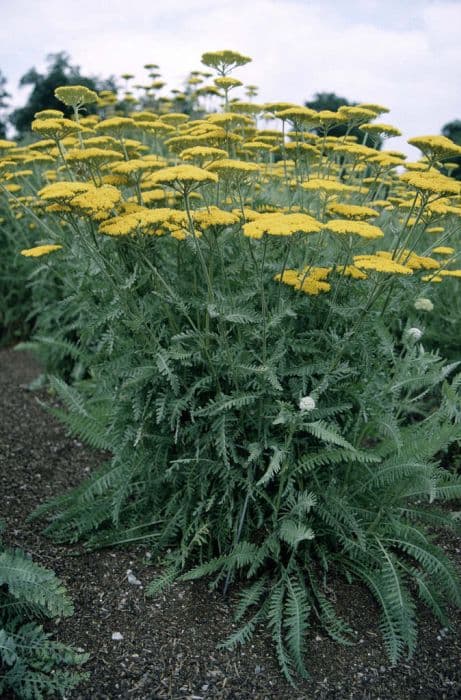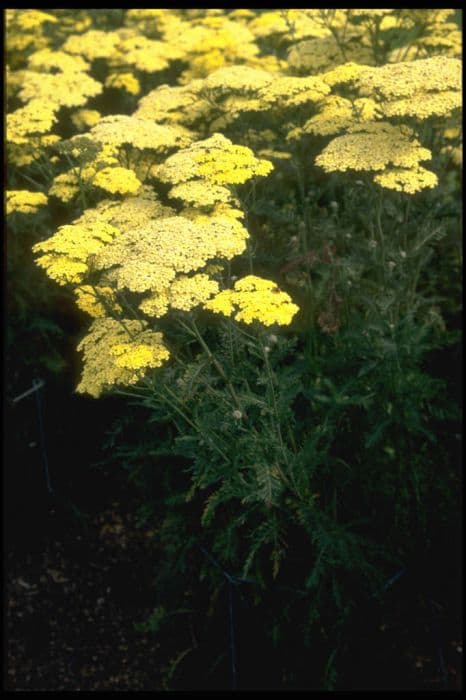Gazania Gazania 'Daybreak Garden Sun' (Daybreak Series)

ABOUT
Gazania 'Daybreak Garden Sun' is a striking flowering plant that is a part of the Daybreak Series popular for its showy appearance. This plant boasts large, daisy-like flowers that are radiant and attention-grabbing. The blossoms come in a mix of bold shades, often featuring a warm palette of yellows, oranges, and reds with a distinctive, darker ring around the center, which can be of a contrasting hue such as deep brown or black. The petals are broad, velvety, and overlapping, giving the flower heads a full, dense look. The foliage of Gazania 'Daybreak Garden Sun' is also attractive, with lance-shaped leaves that are typically green and sometimes have a silvery or grayish tint due to a fine layer of hairs. These leaves form a rosette-like base that anchors the vibrant flowers atop sturdy stems. The plant presents a neat and compact appearance, forming a mound that is as decorative as the blossoms themselves. The overall effect of the Gazania 'Daybreak Garden Sun' in a garden setting is of bright, sunny color spots that attract attention and bring cheerfulness to the landscape. These plants are excellent for adding a splash of long-lasting color to garden beds, borders, and containers. They are commonly used in gardens for their drought tolerance and ability to thrive in sunny and warm conditions, making them a favorite for areas with ample sunshine.
About this plant
 Names
NamesFamily
Asteraceae
Synonyms
Treasure Flower, African Daisy, Gazania
Common names
Gazania rigens var. Daybreak Garden Sun, Gazania splendens 'Daybreak Garden Sun'
 Toxicity
ToxicityTo humans
Gazania is generally considered to be non-toxic to humans. There is no widespread documentation of toxic effects from ingesting this plant, and it is commonly used in gardens and landscaping without special precautions. However, as with any plant, individual allergies or sensitivities could potentially cause mild irritation or an allergic reaction, so it is advisable to avoid ingesting any plant part unless it is known to be edible.
To pets
Gazania is not known to be toxic to pets. It is commonly grown in gardens where pets are present, and there are no significant reports of poisoning or adverse effects from animals ingesting parts of this plant. Nonetheless, pet owners should always monitor their pets and prevent them from eating large quantities of any non-food plants, as they could cause digestive upset or an allergic reaction in sensitive animals.
 Characteristics
CharacteristicsLife cycle
Perennials
Foliage type
Evergreen
Color of leaves
Green
Flower color
Mixed
Height
10 inches (25 cm)
Spread
12 inches (30 cm)
Plant type
Herb
Hardiness zones
9
Native area
South Africa
Benefits
 General Benefits
General Benefits- Drought Tolerance: Gazania is well-suited for dry conditions and requires minimal watering once established.
- Low Maintenance: It requires little upkeep beyond the occasional deadheading to promote further blooming.
- Vibrant Colors: Gazania flowers bring a splash of color to gardens with their bright and varied hues.
- Long Blooming Season: Gazanias bloom for several months, providing long-lasting visual interest.
- Attracts Pollinators: The flowers attract butterflies, bees, and other beneficial insects to the garden.
- Sunlight Resilience: Gazania thrives in full sun and is perfect for sunny, exposed areas where other plants might struggle.
- Heat Tolerance: It can withstand high temperatures, making it ideal for hot summer climates.
- Soil Adaptability: Gazania is adaptable to various soil types, although it prefers well-drained soil.
- Seaside Suitability: Gazania can tolerate salt spray and sandy soils, making it a good choice for coastal gardens.
- Garden Design Versatility: It can be used in rock gardens, as border plants, in container gardens, or as ground cover.
 Medical Properties
Medical Properties- This plant is not used for medical purposes.
 Air-purifying Qualities
Air-purifying QualitiesThis plant is not specifically known for air purifying qualities.
 Other Uses
Other Uses- Gazania can be used as a natural dye source, its bright flowers may allow for the extraction of pigments to color fabrics or artworks.
- As a model organism in studies on floral patterns and pigmentation, Gazania can be helpful for educational purposes in botany and genetics.
- Due to their drought resistance, Gazania can be used in xeriscaping, an environmentally friendly landscaping technique that reduces the need for irrigation.
- Gazania can be used to stabilize soil particularly in sandy areas where erosion is a concern.
- In crafting, dried Gazania flowers can be used for pressed flower art or inclusion in homemade paper for a textured and colorful finish.
- The plant can serve as a living mulch, suppressing weeds and retaining soil moisture when planted densely in gardens.
- Gazania flowers can be used in the classroom to teach children about plant biology and the importance of pollinators through observation and hands-on activities.
- Gazania can be used as a natural indicator for soil pH based on its preferred growing conditions, contributing to garden management practices.
- For photographers and artists, Gazania provides a vibrant subject to capture the intricacies of flower structure and the interplay of light and color.
- Gazania, through its rapid growth and ground-covering ability, can be used in large-scale floral displays or living logos for events or corporate functions.
Interesting Facts
 Feng Shui
Feng ShuiGazania is not used in Feng Shui practice.
 Zodiac Sign Compitability
Zodiac Sign CompitabilityGazania is not used in astrology practice.
 Plant Symbolism
Plant Symbolism- Optimism: The vibrant petals of the Gazania that open with the sunlight symbolize positive energy and an optimistic approach to life.
- Exposure and Vulnerability: Since Gazanias open up during the day and close at night, they can also represent one's willingness to show their true self only in the right conditions.
- Adaptability: These resilient plants thrive in harsh conditions, representing an individual's ability to adapt to various environments.
- Beauty and Diversity: Gazanias come in a range of colors and patterns, which can symbolize the beauty of diversity and the uniqueness of individuals.
- Cheerfulness: The bright and cheerful appearance of the flower often conveys joy and happiness.
- Perseverance: Due to their hardy nature, Gazanias can also represent one's perseverance and dedication to persist through tough times.
 Water
WaterTreasure Flowers should be watered deeply but infrequently, to mimic the dry conditions they naturally prefer. It is best to water these plants once a week, providing about 1-2 gallons of water for each plant, depending on the size and the weather conditions. During the hotter, drier months, you might need to increase watering slightly. Always check the top inch of the soil before watering; it should be dry to the touch. Be cautious not to overwater, as Gazanias are drought-tolerant and susceptible to root rot if left in soggy soil.
 Light
LightTreasure Flowers thrive in full sun where they can receive at least 6 to 8 hours of direct sunlight daily. They perform best when planted in a position where the morning sun can dry the dew on the leaves, reducing the risk of foliar diseases. These plants can tolerate partial shade, but their blooms may not be as prolific or vibrant.
 Temperature
TemperatureTreasure Flowers are best suited to warm temperatures and can tolerate a range from about 40°F to 90°F. They can survive brief periods of colder weather but prolonged exposure to temperatures below 40°F can damage or kill the plant. Ideally, Gazanias prefer daytime temperatures around 70°F to 80°F, which promotes the best growth and flowering.
 Pruning
PruningPruning Treasure Flowers involves deadheading the spent blooms to encourage more flowers and to keep the plant looking tidy. This should be done throughout the blooming season as flowers fade. Additionally, you can trim back any straggly or dead stems in late winter or early spring to promote bushier growth. Pruning is not typically required on a set schedule but done as needed to maintain the plant's appearance.
 Cleaning
CleaningAs needed
 Soil
SoilTreasure flowers prefer well-draining soil with a sandy or loamy texture, and thrive in a pH range between 6.0 and 6.5. A mixture of potting soil with added perlite and coarse sand can provide an ideal growing medium. Ensure that the soil allows for good aeration and drainage to prevent root rot.
 Repotting
RepottingTreasure flowers generally do not need frequent repotting and can be repotted every 2 to 3 years, or when the plant has outgrown its current container. It is best to repot in the spring just before the growing season begins.
 Humidity & Misting
Humidity & MistingTreasure flowers are tolerant of dry conditions and do not require high humidity levels. They grow best in normal ambient humidity found in most homes and gardens, without the need for additional humidity control measures.
 Suitable locations
Suitable locationsIndoor
Place in bright sunlight, water sparingly, and ensure good air flow.
Outdoor
Plant in well-drained soil, full sun, and protect from harsh weather.
Hardiness zone
9-11 USDA
 Life cycle
Life cycleGazania 'Daybreak Garden Sun' or Treasure Flower typically starts its life cycle when seeds are sown in warm soil during spring after the threat of frost has passed. The seed germinates, and a seedling emerges, which will develop its first true leaves following the initial cotyledons. As it matures, the plant develops a robust root system and foliage, entering the vegetative growth phase where it spends energy growing leaves and stems. Upon reaching maturity, it begins the flowering stage, usually in early summer, producing vibrant, daisy-like flowers that attract pollinators and can bloom continuously until the first frost of fall. After pollination, the flowers may produce seeds, completing the reproductive cycle. The plant may either die back at the end of the season if it is treated as an annual, or it may become dormant and regrow the following spring if it is grown as a perennial in suitable climates.
 Propogation
PropogationPropogation time
Spring to Summer
Propogation: Gazania 'Daybreak Garden Sun', commonly known as Treasure Flower, is often propagated by seed since it's a hybrid and doesn't come true from cuttings. The best time for seed propagation is late winter to early spring. To propagate by seed, sow them about 1/8 inch deep in well-draining soil mix, ensuring they receive plenty of light. It's important to keep the soil moist but not soggy, with a temperature between 65 to 70°F (18 to 21°C). Seedlings usually emerge in 7 to 14 days. Once they are large enough to handle, thin them out to prevent overcrowding and transplant the strongest ones to individual pots or their final location in the garden.









